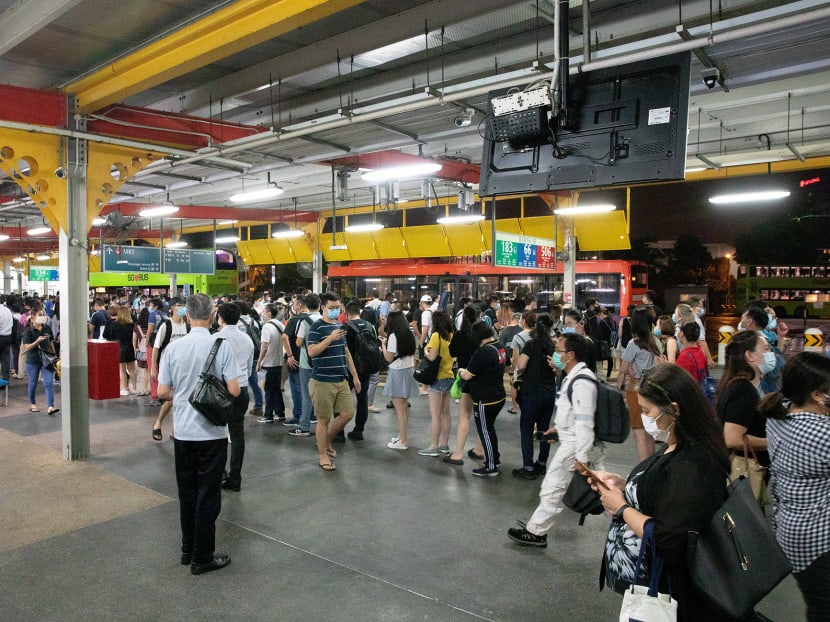Detraining commuters last resort; inevitable that overcrowding occurred during Oct 14 MRT breakdown, says Ong Ye Kung
SINGAPORE — During a train breakdown, having commuters detrain between stations is the last resort but this was carried out during the MRT service disruptions on Oct 14 because power could not be restored quickly enough.

Commuters queuing for free shuttle bus at Jurong East bus interchange on Oct 14 when a fault with the power cables and a circuit breaker along the Tuas West Extension caused a massive train disruption.
SINGAPORE — During a train breakdown, having commuters detrain between stations is the last resort but this was carried out during the MRT service disruptions on Oct 14 because power could not be restored quickly enough.
Having commuters walk along the track poses a risk and needs to be very carefully carried out, said Transport Minister Ong Ye Kung on Tuesday (Nov 3) as he laid out the standard protocols during a train breakdown in Parliament.
Mr Ong was responding to four Members of Parliament (MPs) who fielded questions relating to the breakdown.
Bishan-Toa Payoh Group Representation Constituency MP Saktiandi Supaat asked what protocols were in place to ensure safe distancing for commuters during a breakdown while Tanjong Pagar MP Joan Pereira asked how long it had taken for the crowd control process to kick in.
Mr Ong said that a build up of crowds during such incidents is “inevitable” and that the transport operator has to simply do its best to prevent such breakdowns.
A fault with the power cables and a circuit breaker along the Tuas West Extension caused a massive train disruption on Oct 14 which affected more than 120,000 passengers and train service at 36 stations across three lines for more than three hours.
Forty minutes into the disruption, the operations control centre concluded that it “could not restore power to the system quickly, and decided on detrainment”, said Mr Ong.
He added that all 6,800 commuters on the stalled trains were brought safely to the nearest station platform in under an hour with the exception of 78 commuters whose detrainment was delayed by inclement weather and lightning risk.
To help disperse crowds outside the station, free boarding of regular bus services were in place within 10 minutes of the incident. There were also 120 bridging buses in place within 35 minutes of the incident.
However, there were still crowds around the affected MRT stations.
“While there is understandably concern about overcrowding given the current Covid situation, it will not be practical to ensure physical distancing without further inconveniencing the affected commuters in such an unexpected situation,” he said.
“The transport team simply has to do our best to prevent such incidents from happening in the first place, and to rectify the incidents as quickly as possible should they occur.”
He added that the commuters were cooperative and continued to wear masks and minimised talking to each other.
“I thank the commuters for their understanding and doing their part under trying circumstances.”
In the aftermath of the incident, the Land Transport Authority (LTA) in a briefing last week presented its findings on the disruption. French train manufacturer Alstom will replace 150km of power cables along the Tuas West and will bear the full cost of the replacement.
Two SMRT staff members were also suspended from their duties and must undergo retraining and recertification before they can resume work.
SUSPENSION OF SMRT STAFF NOT NECESSARILY A PUNISHMENT
Hougang MP Dennis Tan asked whether beyond the suspensions, LTA will look into how rail operators can improve their work processes going forward.
Mr Ong said that every major disruption is unique and SMRT had not encountered before such a disruption caused by a cable fault coupled with trip coil faults.
“So (SMRT) will be improving their SOPs (standard operating procedures), but more important than improving their SOPs… It has to be internalised into the experience and lessons learned by all the operators by the engineers,” he said.
“I think this incident provided a lot of lessons for them.”
He added that the suspension of the two SMRT staff members did not mean that they were being blamed or punished.
In settings involving “live operations” and in places where there is a strong safety culture, such suspensions are not uncommon, he said.
“It’s actually carried out quite routinely as a matter of professional conduct and safety protocol… sometimes it is really a matter of retraining — refresh what you have learned, self reflect and go back to do better, and share your learnings with your colleagues,” he added.
“But make no mistake, if there is gross negligence (or) wilful wrongdoing, disciplinary actions will be taken, including even bringing in the police."








